Reviews
At documenta 14, Everything’s a Strategy—Even Bad Hanging
The major art event’s strong political message is weighed down by concept.
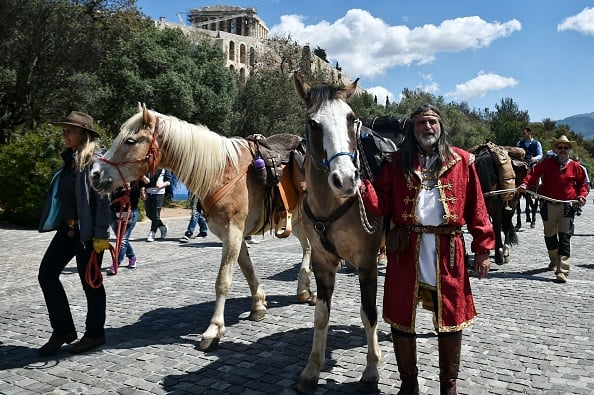
The major art event’s strong political message is weighed down by concept.

The much-anticipated quinquennial exhibition documenta 14 opened to the public on April 8, one day after Greece and EU finance ministers signed an agreement on new austerity measures that would allow the country’s third bailout to proceed, ahead of the July deadline for the payment of over €6 billion of its debt.
On the evening of April 7, the city’s main roads were blocked for traffic as protesters took to the streets; meanwhile, other main routes were fenced off as security measures for the German president Frank-Walter Steinmeier’s official visit to open documenta. Much like everything else at the exhibition, curated by Adam Szymczyk, this coincidence of events felt like a calculated strategy.
However, more often than not, the curatorial team’s carefully scripted decisions were, in fact, deliberately meant to cause confusion. Take for example their listing of Jani Christou’s Epicycle on the website as a work that would be performed on certain days at all documenta 14 venues. The dates on the piece were listed as “1968-2017.” The author, Christou, is a Greek minimalist composer who died in a car accident in 1970. Viewers, logically, went looking for an actual performance.
But Epicycle, it turns out, was not a performance, per se, but a meditation on expanding the idea of music, inviting you to consider the “continuum” of artistic experience as a musical score. “Anyone wishing to participate in the continuum is welcome,” Christou is quoted on documenta’s website, by way of explanation. This writer, therefore, interprets Epicycle‘s inclusion as a conceptual cue that applies to the entire documenta, an invitation to participate in the show more generally.
If this sounds confusing, that is because it is. Reviewing documenta’s many venues, it gradually became clear that not everyone will be “wishing to participate” as an active viewer, at least not outside of the art world, as the exhibition was weighed down by such conceptual sleights of hand.
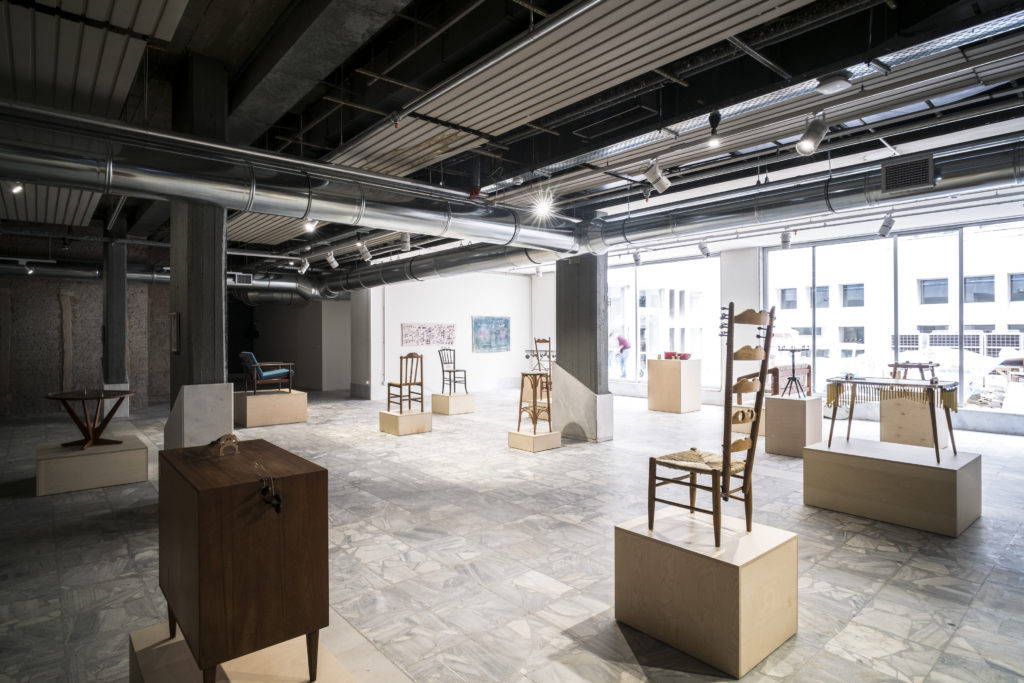
Nevin Aladağ, Music Room (Athens), 2017, installation with furniture, housewares, musical-instrument components, and performances, Athens Conservatoire (Odeion), Athens, documenta 14, photo: Mathias Völzke
Still, the idea of inclusion, at least, seemed key for many of the pieces on view at the Athens Conservatoire, where music played a central role. On the building’s terrace, Norwegian artist Joar Nango built a tiny village resembling a tribal community, with elements taken from different indigenous peoples from around the world. The artist, who comes from Sámi heritage, refers to the installation as a mobile theater, and performances, as well as communal cooking, took place there throughout the first days. When not used as a stage, the site became a playground for toddlers, or a chill-out area for tired parents.
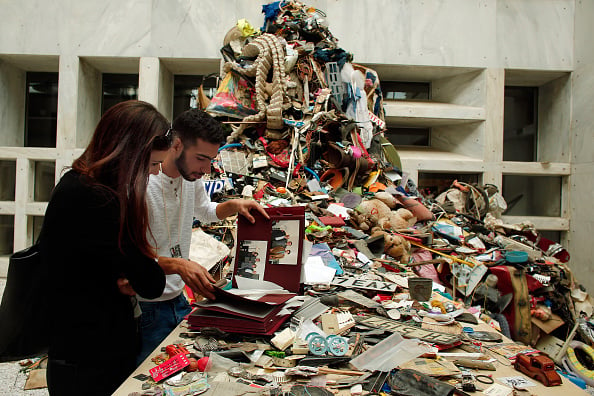
People look at art work Artist book from Daniel Knorr at a preview of Documenta 14, on April 7, 2017 in Athens, Greece. Photo by Milos Bicanski/Getty Images.
Downstairs, occupying the building’s atrium, artist Daniel Knorr was standing at the foot of a mount of scrap materials. Selecting from this pile of bric-a-brac, Knorr pasted pieces of refuse to the pages of books, made upon request as unique artist’s books. Selling at €80 a piece, proceeds would go towards funding his work in Kassel, which will feature smoke coming out of the Fridericianum.
Inside the venue, few works stood out among the many displays of ephemera and documents behind glass vitrines, with important pieces by electronic music heroine Pauline Oliveros or the experimental, short-lived ensemble Scratch Orchestra rendered especially inaccessible to anyone without any pre-existing knowledge of their work.
In general, conventional wall texts were non-existent (in itself not a bad idea), replaced by long paper scrolls on the ground which listed the works’ titles, held in place by rectangular pieces of marble that bore the artist’s name (with many either disappearing in the hands of visitors or not yet placed).
It was the performances that made the venue come alive: Nevin Aladağ’s whimsical furniture-pieces-turned-musical-instruments were activated in improvisational jams several times a day, and 86-year-old experimental composer and influential scholar Alvin Lucier captivated the audience with a live performance of his seminal piece I Am Sitting in a Room, which uses repetition and the frequencies of the space to resonate the room’s spatiality.
Perhaps because music makes up such a big part of the show, and the inherent difficulty of “showing” music as physical artworks, it seemed as if a decision had been made to make the presentation of paintings, sculptures, and installations intentionally indecorous as well. Artworks were rarely given enough space, as if to insist that no visual hierarchy should be allowed to exist between the mediums.
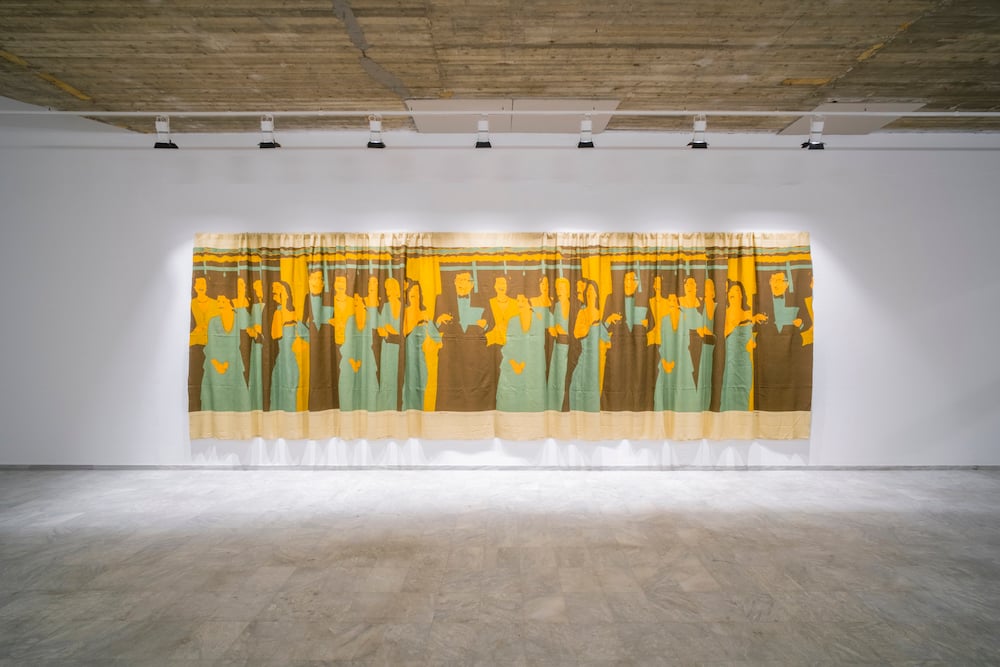
Beatriz González, Decoración de interiores, (1981), Athens Conservatoire (Odeion), documenta 14, Photo: Mathias Völzke
Such was the case with Colombian artist Beatriz Gonzalez’s smart and visually arresting piece Interior Decoration (1981), a 140-meter-long curtain that shows Colombia’s controversial president at the time, Julio Cesar Turbay Ayala, entertaining a coterie of guests. The artist collaborated with textile makers to create the decorative patterned fabric with the party scene in endless repeat, which could be ordered by the meter. But the artwork, on loan from the Tate, was hardly given the space it needs, to show off its sheer scale or give it the proper visual impact.
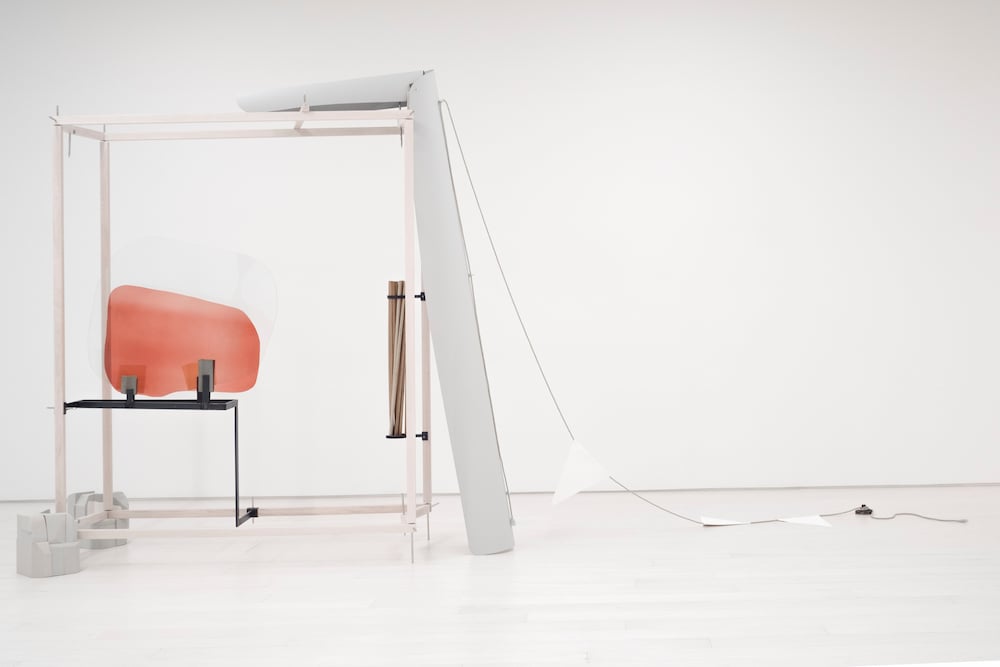
Nairy Baghramian, Drawing Table (Homage to Jane Bowles), 2017, various materials, EMST—National Museum of Contemporary Art, Athens, documenta 14, photo: Mathias Völzke
Other examples of what could only be intentionally ‘bad’ hanging abounded at another venue, the National Museum of Contemporary Art (EMST). A new artwork by Nairy Baghramian, Drawing Table (Homage to Jane Bowles) (2017)—one of just a few works on view produced especially for documenta—is a brilliant balancing act of over-layering, an assemblage of items meant to somewhat suggest items from a short story by the American author Jane Bowles. The dense work is cornered on one side by Ashley Hans Scheirl’s brightly colored paintings, and pushed to the wall by proximity to more glass display tables, of which there are many.
Similarly, Yael Davids’s elegant installation centering on the difficult biography of poet Else Lasker Schüler, felt cornered. A poignant piece by Moyra Davey showing photographs she had folded like envelopes and sent from her home in New York State to the documenta curators in Athens, is hung on the wall of a long corridor in a room overladen with other works.
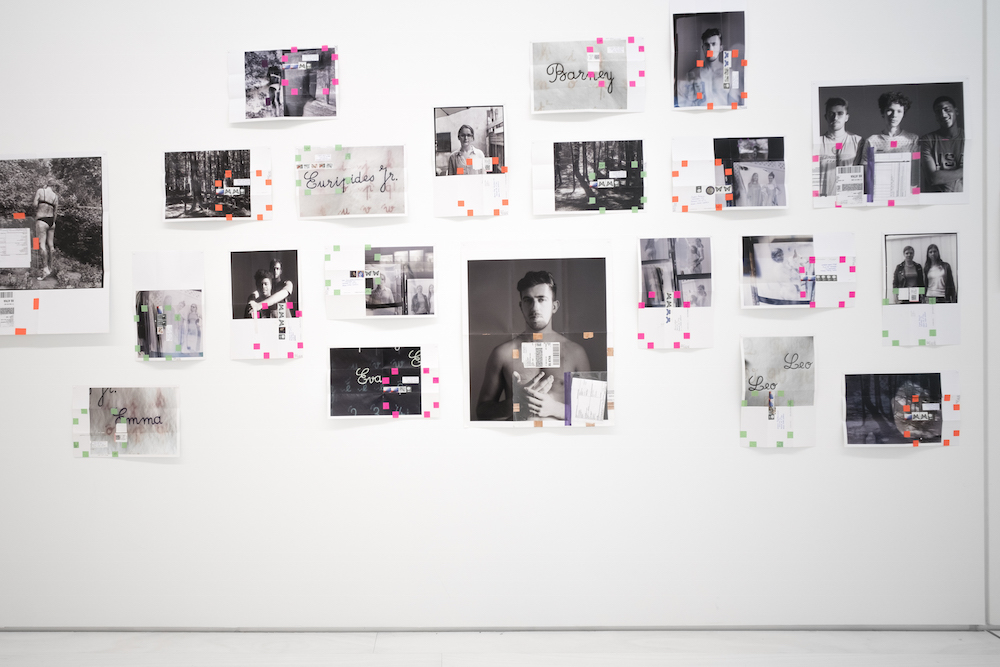
Moyra Davey, Portrait/Landscape (2017), 70 C-prints, installation view, EMST—National Museum of Contemporary Art, Athens, documenta 14, photo: Mathias Völzke
Downstairs, almost an entire room was dominated by the ritualistic masks and wooden sculptures of Kwakwaka’wakw artist Beau Dick, who passed away on March 27, days before the opening. But around the room’s perimeter were pieces by other artists whose presence was unexplained and indecipherable. They were a distraction, if at all noticed.
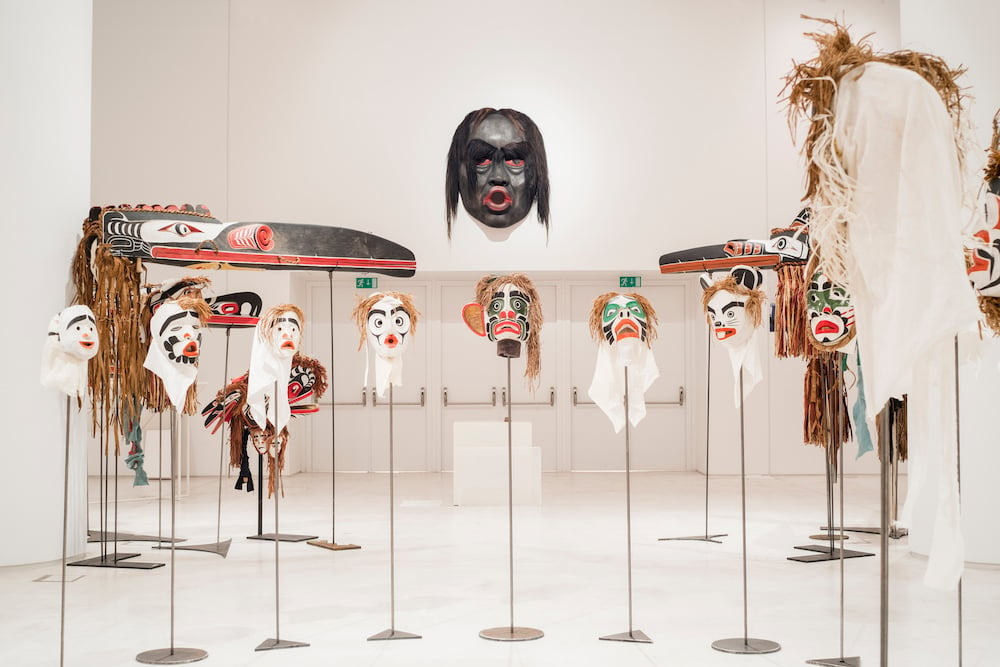
Beau Dick, Twenty-two masks from the series ”Atlakim”, 1990–2012, various materials, installation view, EMST—National Museum of Contemporary Art, Athens, documenta 14, photo: Mathias Völzke
The list goes on. Yet in some cases, it was evidently the choice of the artist. Douglas Gordon showed his latest film, I had nowhere to go, based on the eponymous autobiography of Lithuanian filmmaker Jonas Mekas, at a traditional local open-air cinema nestled inside an inner courtyard. For this first screening of the season, foliage had overgrown to obfuscate the screen, and was left untouched. When asked about it after the powerful film—which includes long stretches of only audio featuring Mekas’s voiceover, and at one point, a very long sound sequence of a bombardment—had ended, Gordon replied that he didn’t see why the branches should be cut.
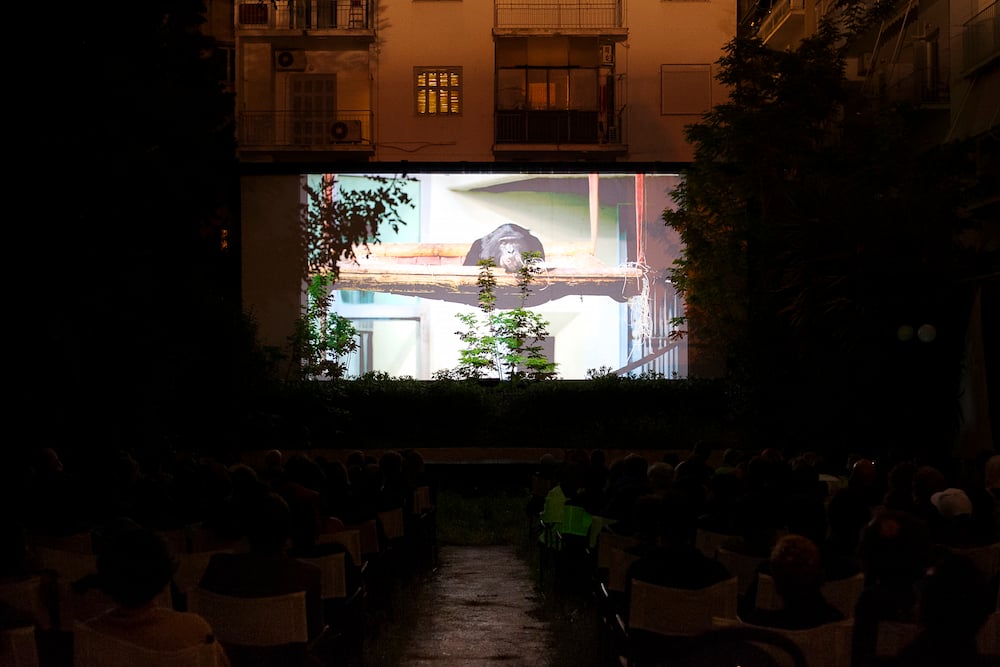
Douglas Gordon, I had nowhere to go, 2016, digital video transferred from Super 8 film and video, installation view, Municipal Cinema Stella, Athens © Douglas Gordon/VG Bild-Kunst, Bonn 2017, documenta 14, photo: Stathis Mamalakis
It is all the more puzzling, then, that certain works are given ample space, and long explanatory texts.
An entire room with a museum-like, grey-toned wall encloses the curious project by Piotr Uklanski, who invited artist duo McDermott & McGough to show works from their 2001 series “Hitler and the Homosexuals,” alongside his own series based on Leni Riefenstahl’s film Olympia. The viewer is welcomed by Uklanski’s uninteresting paintings, and a mildly offensive text explaining (or justifying?) the double entendre in the installation’s title, The Greek Way.
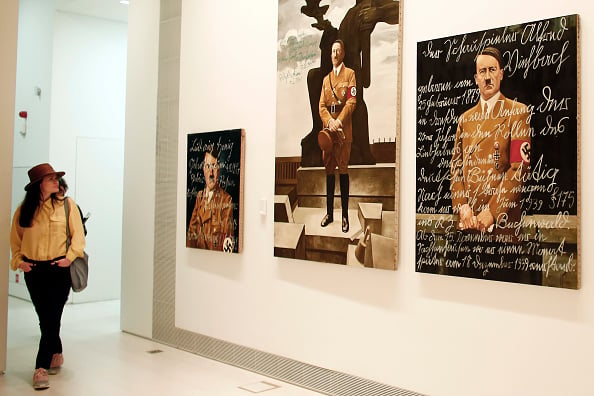
A woman looks at a piece of work ttitled The Greek way which is an installation that juxtaposes the work of Piotr Uklanski and McGouth at a preview of Documenta 14 at the EMST- National Museum of Contemporary Art on April 6, 2017 in Athens, Greece. Photo by Milos Bicanski/Getty Images.
At the Benaki museum, a venue where most of the works centered on narrative, another black-humor Holocaust joke comes courtesy of Israeli artist Roee Rosen, who’s showing an old piece, from 1995-1997, called Live and Die as Eva Braun. It imagines, in a room-filling installation of text and drawings, the last days of Hitler’s secretary and lover.
Why, besides its focus on narrative, would the curators choose to present Rosen’s monumental jest—which naturally caused a stir when it was first exhibited in the Israel Museum—in the same context as a piece like Thai artist Arin Rungjang’s video And then there were none (Tomorrow we will become Thailand) (2016) is anyone’s guess. The latter, a one-channel video, weaves the stories of two sites of popular uprising, the Democracy Monument in Bangkok and the National Technical University in Athens, which became the site of a bloody uprising against the Junta in 1973. A new work produced for documenta 14, it was presented in a small screening room that was easily overlooked.
Needless to say, this documenta is highly political, and there are many powerful and striking works across all venues. But by means of their presentation, they are shorn of their physical impact, as if their very materiality is inappropriate. With news of the chemical strike in Syria, followed by Trump’s retaliatory airstrike, flooding the media with images of suffering on the opening days of documenta and—as Syrian filmmaker Charif Kiwan, a member of the Abounaddara collective, stressed at the press conference—the indignity thus imposed on the victims, why should there be any place here for beauty?
Not even a work that is pure ceremonial gesture was given an overly festive launch. On Sunday, a procession of horses embarked on a 100-day ride from the south slope of the Acropolis in Athens to Kassel as a piece by artist Ross Birrell: A few speeches in the sun, with long thank-yous to sponsors, including the tourist café across the street, and the group was sent off.
Whether documenta’s strategies of directed confusion and, at times, negligent inaccessibility make for a successful event remains to be seen. During the opening weekend, however, another exhibition, unrelated to documenta, was described by many as far more engaging.
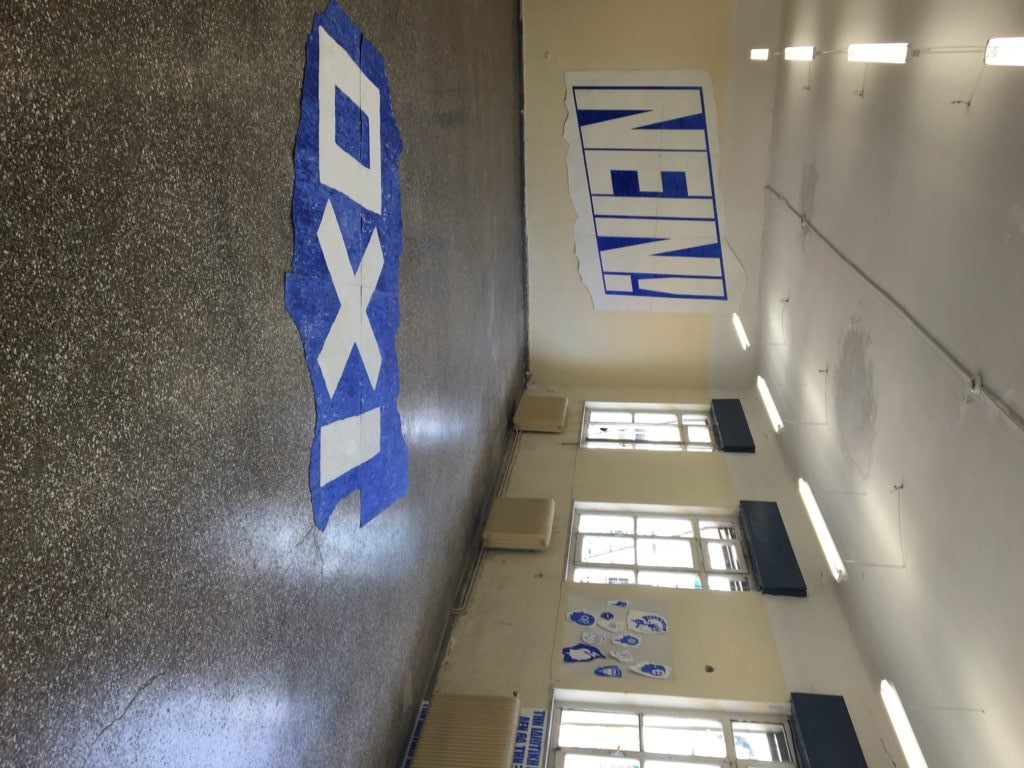
Michael Landy, “BREAKING NEWS-ATHENS.” Presented by NEON. Diplarios School, Athens. Photo: Hili Perlson
At the empty building of the Diplarios School, artist Michael Landy presented his “BREAKING NEWS-ATHENS.” The artist used graffiti found on the streets of Athens as well as suggestions crowdsourced online for imagery, slogans, and pictograms that serve as pithy commentary on the situation in Greece. These were then etched on clay-covered sheets in an onsite workshop, with help of local artists, and hung on the walls in the empty classrooms, halls, and even bathrooms. Anyone who sent in a suggestion that the artist ended up realizing would receive the artwork with their own design when the show closes, on June 11.
In a recent interview with the German Kulturradio, Szymczyk insisted that the documenta was never intended to engage with the local art scene, as that would be too limited a scope for the exhibition. Unfortunately, this strategy resulted in a major show that often feels aloof.
documenta 14 is on view until July 16 in Athens, and from June 10 to September 17 in Kassel, Germany.